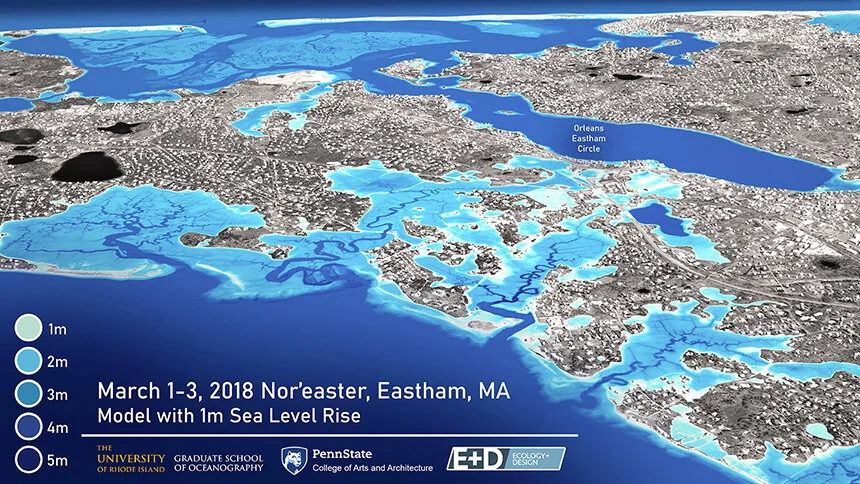Study to look at relationship of sea-level rise and flooding in hurricanes and nor’easters
Realistic 3D visualization for Eastham, Mass., along the Cape Cod National Seashore using advanced modeling results of a March 2018 nor'easter with 3 feet of sea-level rise
From ecoRI News (ecori.org)
KINGSTON, R.I. — Researchers at the University of Rhode Island and Pennsylvania State University were recently awarded a four-year, $1.5 million grant through the National Oceanic and Atmospheric Administration (NOAA) to study the effects of sea-level rise and how it may exacerbate the impact of extreme weather.
The project will draw on expertise from researchers at URI’s Graduate School of Oceanography, its College of the Environment and Life Sciences, the Department of Ocean Engineering, and the URI Coastal Resources Center.
Other collaborative participants include the Schoodic Institute, in Maine, and the National Park Service. The goal of the project is to help communities, the National Park Service, and the U.S. Fish & Wildlife Service adapt to a changing climate and more frequent and extreme weather.
The rate of sea-level rise is accelerating, according to NOAA. Since 1993, the average global sea level has increased by 3.4 inches. Sea level plays a role in flooding, shoreline erosion and other hazards, impacting nearly 40 percent of the U.S. population living in high-density coastal areas.
However, despite what is known about sea-level rise, there is a lack of research available when it comes to how the impacts of nor’easters and hurricanes may be amplified as a result.
“There are a number of studies that have been done looking at just sea-level rise or just extreme weather, but what we're really lacking in terms of clear understanding is the combined impact of these two phenomena,” said Isaac Ginis, a URI professor of oceanography who is leading the study. “This is especially important to us on the East Coast and in New England, where we’ve seen significant coastal flooding produced by waves and storm surge during nor’easters and hurricanes. How these effects are amplified by sea-level rise has been largely unexplored. This information gap inhibits our ability to properly plan for the future and is likely to lead to under-informed and ineffective adaptation measures.”
The project will expand the body of research related to the effects of extreme weather and sea-level rise on five New England national parks and two wildlife refuges — Cape Cod National Seashore, Boston Harbor Islands National Recreation Area and New Bedford Whaling National Historical Park, in Massachusetts; Ninigret National Wildlife Refuge, Trustom Pond National Wildlife Refuge and Roger Williams National Memorial, in Rhode Island; and Acadia National Park, in Maine, as well as their surrounding communities.
Using atmosphere, storm surge and wave/erosion modeling the team will provide high-resolution recreations of the impact of future storm and sea-level rise scenarios, identifying vulnerabilities in the ecosystems and infrastructure of the identified sites and their adjacent communities. The modeling will also include hazard, risk, and adaptability assessments, and mitigation scenarios.
Researchers will work closely with the National Park Service, U.S. Fish & Wildlife Service, and stakeholders at the community level to tailor the research and translate the science in a way that can be incorporated into local resource management and adaptation measures to improve coastal resilience and to protect communities, people, infrastructure, and ecosystems.
“Each community has their own needs,” said Ginis, “but our modeling results will produce tailored and tangible information for local decision-makers — state and local governments, emergency management officials, town and city planners, and other stakeholders — to address their specific needs and enable them to plan and adapt as the sea-level rises and climate continues to change.”
Taking historical data into account, as well as topography, geology, water depth, land elevation, natural processes such as shoreline changes, and human influence, the team will be able to project more than 50 years into the future, using 3D visualization to provide computer simulations illustrating storm hazards and identifying potentially effective mitigation measures.
Ultimately, the project will open an important dialogue among researchers, local stakeholders, and federal resource managers, and facilitate the development of science-based best practices that will guide future policies and resource management strategies.
